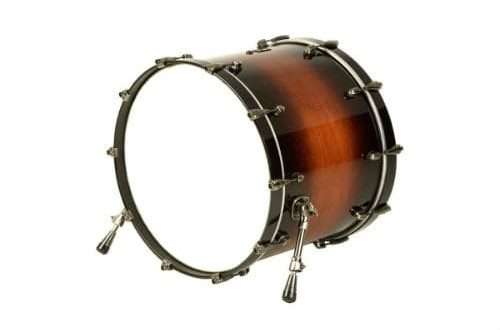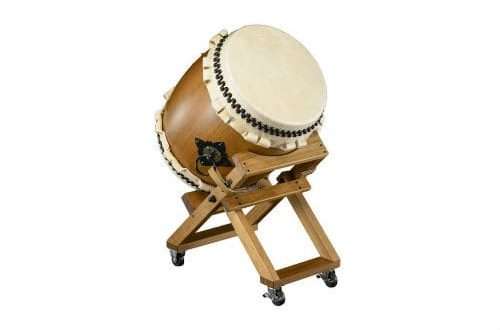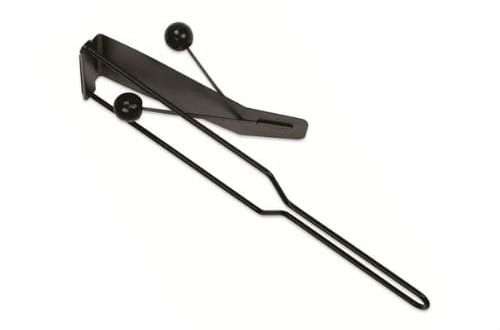
Xylophone: description of the instrument, sound, composition, varieties, use
Contents
The xylophone is a musical instrument that has a simple structure and an ancient history dating back thousands of years. Despite the seeming primitiveness, only professionals can make it sound as it should.
What is a xylophone
The xylophone belongs to percussion musical instruments (the closest “relative” is the metallophone). Has a certain pitch. It looks like a set of wooden planks of different sizes. To extract sound, you need to hit them with special sticks (hammers).

Each bar in its composition is tuned to a specific note. The sound range of a professional instrument is 3 octaves.
The xylophone sounds differently, it all depends on the material of the sticks (rubber, plastic, metal), the impact force. A timbre from soft to sharp, similar to a click is possible.
Set up the xylophone
At the heart of the device is a frame on which, by analogy with the keys of a piano, wooden blocks are arranged in two rows. Each beam lies on a pad of foam rubber, between the pad and the beam there is a special tube, the purpose of which is to enhance the sound. Resonator tubes timbre color the sound, make it brighter, more expressive.
For the keys, valuable, hardwoods are chosen. Before creating a tool, wooden blanks are thoroughly dried, sometimes the drying process takes several years. The width of each bar is standard, the length varies depending on what height the sound needs to be received during the Play.
They make sound with sticks. Standard set – 2 pieces. Some musicians masterfully cope with three, four sticks. The material of their manufacture may be different.
The tips of the sticks have a rounded shape, they are enclosed in leather, felt, rubber – depending on the nature of the piece of music.
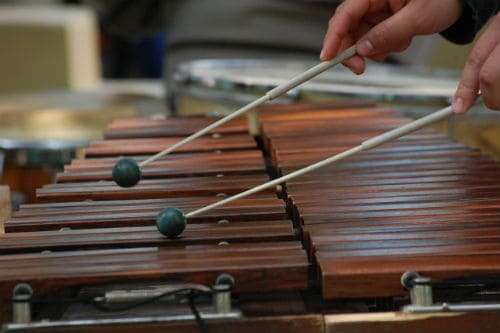
What does a xylophone sound like?
The xylophone sounds unusually, abruptly. He is included in the orchestra, ensemble, wanting to display a peculiar plot. The tool is able to create the illusion of gnashing of teeth, an ominous whisper, the clatter of feet. He perfectly conveys the experiences of the main characters, the nature of the actions. Most of the sounds made are dry, clicking.
Virtuosos are able to “squeeze out” all sorts of tones from the design – from piercing, ominous to gentle, light.
History of the tool
The first models of musical instruments resembling a xylophone appeared more than 2 thousand years ago. They have not been preserved – ancient drawings found on the territory of modern Asia, Latin America, and Africa testify to the existence of objects.
For the first time in Europe, such a design was described in the XNUMXth century. For ease of development, wandering musicians fell in love with it, until the XNUMXth century it was used mainly by them.
The year 1830 marked a turning point in the history of the xylophone. The Belarusian master M. Guzikov undertook to improve the design. The specialist arranged the wooden plates in a certain order, in 4 rows, brought the resonating tubes from below. Innovations made it possible to expand the range of the model up to 2,5 octaves.
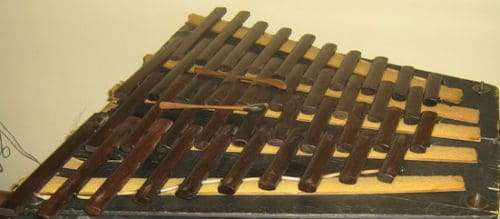
Soon the innovation attracted the attention of professional musicians and composers. The xylophone became part of the orchestras, later it became possible to perform solo parts.
After 100 years, another change took place in the appearance of the wooden metallophone. Instead of 4 rows, 2 remained, the bars were arranged like piano keys. The range has exceeded 3 octaves, making the instrument more flexible and expanding its musical possibilities. Today, the xylophone is actively used by pop performers, orchestras, and soloists.
Varieties of the xylophone
Varieties of the xylophone are scattered throughout the globe. Here are just a few of them:
- Balafon – common in a number of African countries. The basis is made up of 15-20 boards made of hard wood, under which resonators are placed.
- The timbila is the national instrument of the Republic of Mozambique. Wooden keys are attached to ropes, massala fruits serve as resonators.
- Mokkin is a Japanese model.
- Vibraphone – invented by the Americans at the beginning of the XNUMXth century. Feature – metal keys, the presence of an electric motor.
- Marimba is an African, Latin American type of instrument, a distinctive characteristic is sticks with rubber heads, a pumpkin as a resonator.
Models can also be classified into:
- Diatonic – easy to learn, the plates form a single row, repeating the arrangement of the white keys of the piano.
- Chromatic – harder to play: the keys are arranged in two rows, representing a sequence of black and white piano keys. The advantage of the model is wider musical possibilities for reproducing sounds.
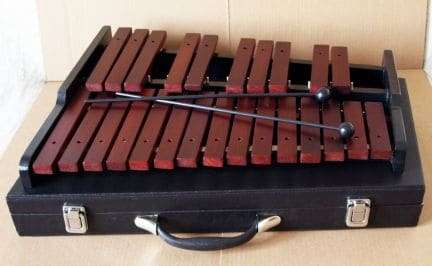
Using
An interesting fact: initially the instrument was used exclusively as a folk instrument. Today it is actively used by musicians of brass, symphony, variety orchestras. There are groups of only xylophonists.
Xylophone sounds are present in some rock, blues, jazz compositions. There are frequent cases of solo performances using this instrument.
Famous Performers
The first xylophonist virtuoso was the creator of the modern version of the instrument, Belarusian M. Guzikov. Subsequently, the talents of K. Mikheev, A. Poddubny, B. Becker, E. Galoyan and many others were revealed to the world.



